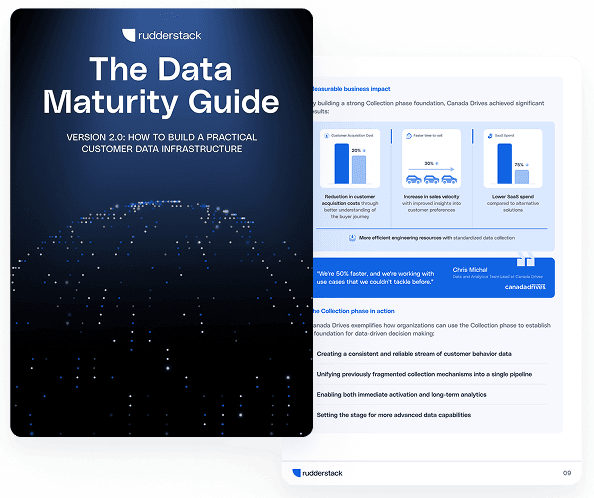Data life cycle: Stages, importance, and best practices

Data never stands still. From the moment it's created, every piece of information begins a journey that shapes its value, risk, and impact on your business.
But without a clear understanding of that journey, your data can easily become fragmented, stale, or noncompliant. That's why mastering the data life cycle, from collection and storage to activation and deletion, is essential for driving growth, ensuring governance, and staying agile.
In this guide, we'll break down each phase of the data life cycle, explain why it matters, and share best practices to help you maximize the value of your data at every stage. You'll also learn how RudderStack's cloud-native infrastructure helps you collect, transform, govern, and activate data throughout its entire life span securely and in real time.
Main takeaways:
- The data life cycle consists of six key stages: collection, storage, processing, sharing, analysis, and retirement, each requiring tailored governance and infrastructure
- Effective data lifecycle management improves data quality, reduces risk, enhances compliance, and drives better decision-making across teams
- Secure storage and robust governance, including access controls, metadata, and compliance policies, are critical for maintaining data integrity
- Processing and transforming raw data through validation, enrichment, and standardization is essential for enabling high-impact analytics
- Retiring or deleting data responsibly ensures regulatory compliance and cost efficiency while closing the loop in the data life cycle
What is the data life cycle and why does it matter?
The data life cycle refers to the end-to-end journey data follows from creation to deletion. It consists of six main stages: planning and collection, storage, processing, sharing, analysis, and retirement or deletion, aligning well with the USGS Science Data Lifecycle Model. Understanding this cycle helps organizations properly manage their data assets while maintaining compliance with regulations.
The data cycle is critical because it provides a framework for maintaining data quality and security throughout its useful life. Without proper management, organizations risk data breaches, compliance violations, and missed opportunities to extract value from their information assets.
Data lifecycle management refers to the policies, processes, and tools used to manage data effectively through each phase of its existence. This approach ensures data remains accurate, accessible, and protected at every stage of the life cycle of data.
| Aspect | Manual approach | Automated lifecycle management |
|---|---|---|
| Data validation | Periodic checks | Real-time validation at collection |
| Access controls | Role-based automation with audit logs | Ad hoc permission updates |
| Data sharing | Manual exports via email or files | Governed APIs or scheduled pipeline syncs |
| Deletion | Risk of oversight | Policy-driven expiration and purge routines |
What are the key benefits of managing the data lifecycle?
- Improved data quality: Consistent processes ensure accurate, reliable data by establishing standardized collection methods, validation protocols, and cleansing procedures that minimize errors and inconsistencies
- Enhanced security: Proper controls protect sensitive information through encryption, access management, and audit trails that safeguard data from unauthorized access while maintaining visibility into usage patterns
- Regulatory compliance: Structured management meets legal requirements by documenting data lineage, enforcing retention policies, and enabling rapid response to data subject requests under frameworks like GDPR and CCPA
- Cost efficiency: Optimized storage and processing reduce expenses through intelligent tiering, compression algorithms, and automated archival policies that align storage costs with data value and access frequency
- Better decision-making: High-quality data leads to more informed choices by providing stakeholders with trustworthy, contextualized information that reveals meaningful patterns and supports confident business decisions
What are the key steps in the data life cycle?
The data lifecycle phases follow a logical progression that ensures information remains valuable and protected. Each phase builds on the previous one, creating a continuous cycle of data management.
1. Plan and collect high-quality data
The data management lifecycle begins with strategic planning that defines exactly what data you need and precise methods for collection. Start by articulating specific business objectives, whether increasing conversion rates, reducing churn, or optimizing supply chains, then map the exact data points required to achieve these goals.
Many organizations now implement formal data management plans (DMPs), which have become mandatory requirements from research funders and regulatory bodies. These structured documents outline data handling protocols, ownership rights, and quality standards upfront, effectively preventing the accumulation of unnecessary data that bloats storage costs, increases security vulnerabilities, and creates compliance liabilities.
Data collection methods should align with your specific business context:
- Web and mobile tracking: Deploy JavaScript snippets, SDKs, and pixel-based solutions to capture granular user interactions, including clicks, form completions, scroll depth, and session duration across websites and mobile applications
- API integrations: Establish secure, authenticated connections with third-party platforms like payment processors, CRM systems, and marketing tools to extract structured data through REST or GraphQL endpoints
- System logs: Implement automated log collection from servers, applications, and network devices to gather performance metrics, error reports, and security events that reveal operational patterns
- Manual entry: Utilize structured forms with validation rules and dropdown menus to minimize transcription errors when human input is necessary for qualitative data or offline interactions
The decision between batch and real-time collection creates fundamental tradeoffs in your data architecture. Batch processing optimizes resource efficiency for large-volume transfers and historical analysis, typically running during off-peak hours to minimize system impact.
Ready to take control of your entire data life cycle? Request a demo to see how RudderStack helps you streamline every stage.
2. Store and govern data securely
Once collected, data must be stored securely with proper governance controls. The information life cycle requires careful management of where data lives and who can access it. Your storage architecture should align with specific use cases:
- Data warehouses: Optimized for structured data and complex queries with columnar storage that accelerates analytics workloads (e.g., Snowflake, BigQuery, Redshift)
- Data lakes: Designed for raw, unprocessed data in native formats, supporting diverse workloads from machine learning to exploratory analysis (e.g., Azure Data Lake, AWS S3 with Athena)
- Cloud object storage: Cost-effective repositories for semi-structured and unstructured data with tiered access patterns that balance performance and cost (e.g., AWS S3, Google Cloud Storage)
Data governance establishes rules for data access, quality, and usage through four critical mechanisms:
- Access controls: Implement least-privilege principles with role-based permissions that limit exposure to sensitive data while maintaining audit trails of every access attempt
- Metadata management: Deploy data catalogs that document origins, transformations, and business context, enabling users to understand data provenance and trustworthiness
- Compliance controls: Enforce regulatory guardrails through automated classification of PII, PHI, and financial data with corresponding protection measures based on data sensitivity
- Data quality frameworks: Establish automated monitoring for completeness, accuracy, and consistency with alerting thresholds that trigger remediation workflows when quality degrades
The data cycle requires layered security measures to protect sensitive information. Implement end-to-end encryption (both at-rest and in-transit), comprehensive access logging with anomaly detection, and quarterly penetration testing to identify vulnerabilities before they become breaches.
3. Process and transform data for usability
Raw data rarely delivers immediate value. The processing life cycle transforms collected information into usable formats through several techniques:
- Cleaning to remove errors and duplicates, detecting and eliminating null values, outliers, and redundant records that can skew analysis
- Validation to ensure data meets quality standards, applying business rules and statistical checks to verify accuracy, completeness, and consistency
- Enrichment to add context and value, augmenting first-party data with third-party attributes like demographic information, behavioral scores, or industry classifications
- Aggregation to summarize for analysis, consolidating granular data points into meaningful metrics like daily averages, conversion rates, or customer segments
The data analysis life cycle depends on properly processed information. You can use either ETL (Extract, Transform, Load) or ELT (Extract, Load, Transform) approaches depending on your data volume and processing needs. ETL works best for structured data with complex transformations, while ELT excels with large-volume, diverse datasets where exploration is prioritized.
The data cycle steps for processing include:
- Data validation: Implementing automated quality checks that flag anomalies like impossible values (e.g., negative ages), format violations, or statistical outliers that deviate from expected patterns
- Standardization: Converting disparate formats into unified structures, normalizing phone numbers (e.g., +1-555-555-5555), date formats (ISO 8601), or address components across international boundaries
- Enrichment: Enhancing core data with calculated fields, derived metrics, or external reference data that provides crucial business context and analytical depth
- Transformation: Restructuring data through joins, pivots, aggregations, and dimensional modeling to optimize for specific analytical workloads and business questions
4. Share and publish data across teams and tools
The fourth phase in the data life cycle involves making processed data available to those who need it. This requires careful balance between accessibility and security, with governance guardrails that prevent data sprawl while enabling authorized innovation.
Data sharing methods include:
- Direct database access with permission controls, using row-level security, column masking, and role-based policies that limit exposure based on job function and data sensitivity
- API-based data services for applications, implementing rate-limited, authenticated endpoints with documented schemas that enable controlled, real-time data consumption
- Scheduled reports and dashboards, delivering automated insights through self-service visualization platforms with embedded context and metric definitions
- Data marketplaces for broader distribution, creating searchable catalogs where users can discover, request access to, and consume vetted datasets with clear usage policies
Proper documentation is essential during this phase, as recommended by the Data Curation Network. Users need to understand what the data represents, where it came from, and how they should use it. This metadata should include field definitions, update frequency, known limitations, and example use cases. Without context, even high-quality data can lead to incorrect conclusions or misguided business decisions.
5. Analyze and activate your data in real time
Analysis transforms raw data into actionable insights that fuel strategic business decisions. The analytical life cycle encompasses four distinct yet complementary approaches:
- Descriptive analytics to understand what happened: examining historical patterns through dashboards and reports that visualize key metrics like conversion rates, user engagement, and revenue trends
- Diagnostic analytics to determine why it happened: applying statistical techniques and drill-down analysis to identify root causes behind performance fluctuations, customer behavior shifts, or operational anomalies
- Predictive analytics to forecast what might happen: leveraging machine learning algorithms and statistical models to anticipate future outcomes, from customer churn probability to inventory requirements
- Prescriptive analytics to recommend actions: generating specific, data-driven recommendations through optimization algorithms and decision trees that maximize desired outcomes
Real-time analysis enables immediate response to emerging trends or issues. This capability delivers critical competitive advantages for time-sensitive use cases like fraud detection or personalization.
Data lifecycle management increasingly focuses on activation, putting insights to work in operational systems. This closes the loop between analysis and action, making data truly valuable to the business.
6. Retire, archive, or delete data responsibly
The final phase in the life cycle of data handling involves responsible retirement. Not all data remains valuable forever, and keeping unnecessary information increases costs and risks.
Your options at this stage include:
- Archiving rarely-accessed data to low-cost storage
- Deleting data that's no longer needed
- Anonymizing sensitive information for long-term retention
- Purging data based on retention policies
What is data lifecycle management if not a complete process? It must include proper end-of-life handling to be effective. Regulations like GDPR and CCPA require organizations to delete personal data upon request, making this phase critical for compliance.
The 6 stages of the data life cycle form a continuous process. As some data reaches retirement, new data enters the collection phase, creating an ongoing cycle of management.
Power your entire data life cycle with RudderStack
Managing the data lifecycle effectively requires purpose-built infrastructure. RudderStack provides cloud-native customer data infrastructure that supports each phase, from collection to activation.
RudderStack's approach to the data development life cycle emphasizes security, control, and flexibility. Unlike traditional solutions that store your data in their systems, RudderStack works with your existing data infrastructure, giving you complete ownership.
Key capabilities include:
- Real-time data collection with built-in privacy controls
- Flexible transformation options for data processing
- Secure delivery to your warehouse and business tools
- Support for identity resolution and profile management
- Privacy automation for compliance requirements
The data governance lifecycle benefits from RudderStack's approach to schema validation, consent management, and audit logging. These features help maintain data quality and compliance throughout the lifecycle.
Ready to optimize your data life cycle? Request a demo to see how RudderStack can help.
Published:
August 25, 2025

Generative AI risks and how to approach LLM risk management
Explore the top generative AI risks—hallucinations, data leakage, prompt injection, and compliance gaps—and learn strategies to detect, mitigate, and govern them effectively.

Data standardization: Why and how to standardize data
When teams cannot rely on their data, reporting slows down and decision-making becomes riskier. Learn how standardization addresses these challenges by creating a consistent structure that data can follow from the moment it enters your system.

Understanding data maturity: A practical guide for modern data teams
The journey to data maturity isn't about having the most sophisticated tools or even the biggest volume of data. It's about taking the right steps at the right time to unlock value from the data you have.





